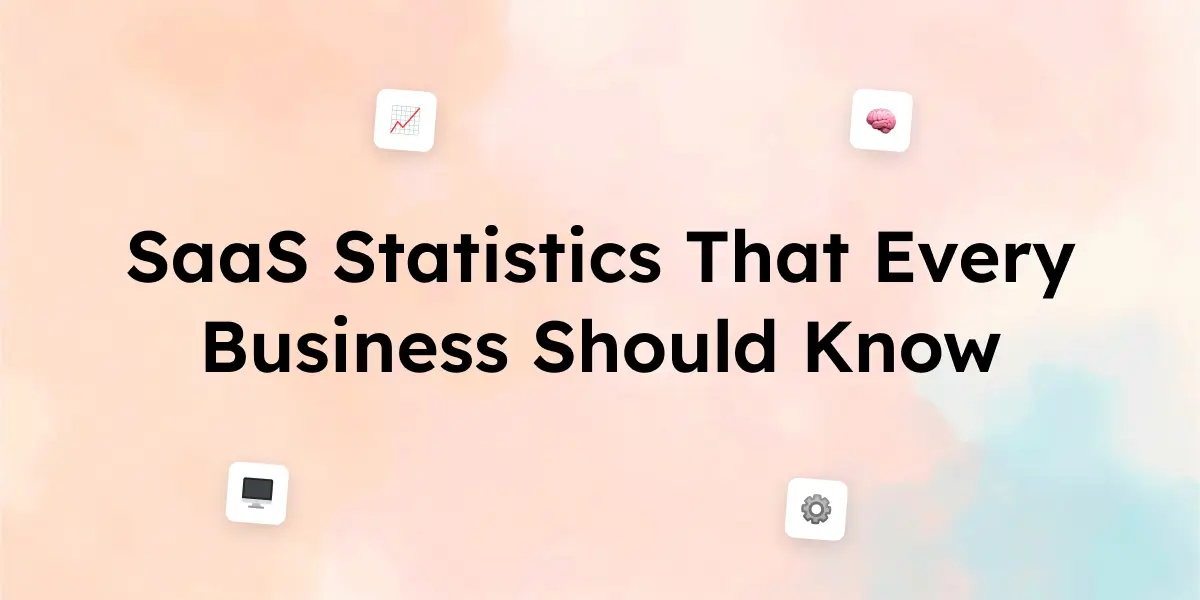SaaS (Software-as-a-Service) continues to dominate the business landscape, driving efficiency, scalability, and revenue growth. Whether you’re a startup or an enterprise, staying updated on key SaaS trends is crucial for strategic decision-making. Below are 45 must-know SaaS statistics for 2025, covering growth, adoption, revenue trends, and customer behavior.
45 SaaS Statistics
1. SaaS Market Growth & Adoption
- 🌍 The global SaaS market will hit $374.5 billion by 2025, growing at 11.5% CAGR
- 🚀 99% of businesses are using at least one SaaS solution in 2025.
- 🔥 80% of businesses will increase SaaS spending in 2025.
- 🏢 The average mid-sized company uses 185 SaaS applications, up from 80 in 2020.
- 💻 75% of new business applications in 2025 will be SaaS-based.
2. SaaS Revenue & Business Models
- 💰 The top 10 SaaS companies (Salesforce, Microsoft, Adobe, etc.) generate $150B+ annually.
- 📈 Subscription revenue models account for over 80% of SaaS revenue.
- 🔁 30-50% of SaaS revenue comes from existing customers through renewals and upsells.
- 💳 Usage-based pricing adoption increased by 40% YoY, making it a major trend.
- ⏳ The average time to reach $1M ARR for SaaS startups is 2.3 years.
3. SaaS Customer Behavior & Retention
- ❌ The average B2B SaaS churn rate is 5-7% annually, while B2C SaaS churn is 30-40%.
- 👥 Only 16% of SaaS customers say they fully utilize all features of their software.
- 🎯 92% of SaaS companies say customer success efforts are critical to reducing churn.
- 🏆 94% of B2B SaaS buyers research a company online before making a purchase.
- 📈 Loyal SaaS customers spend 67% more than new customers
4. SaaS Marketing & Sales Trends
- 🔍 SEO drives 68% of inbound traffic for SaaS businesses, making it the top acquisition channel.
- 🎥 Video marketing increases SaaS conversions by 34%.
- 🛠️ Freemium models convert at an average rate of 4% to 8%.
- 📧 Email marketing has an average ROI of $42 per $1 spent for SaaS.
- 🤝 Referral programs drive 3x higher conversion rates than other marketing tactics.
5. AI & Automation in SaaS
- 🤖 By 2025, 60% of SaaS products will include AI-powered features.
- 🔄 Automated workflows can cut operational costs by 30% for SaaS companies.
- 💡 AI-powered chatbots now handle 80% of SaaS customer inquiries.
- 📊 SaaS companies using AI in analytics experience a 20% increase in customer retention.
- ⚡ AI-driven personalization can increase SaaS product adoption rates by 25%.
6. Cybersecurity & Compliance in SaaS
- 🔒 85% of SaaS businesses consider security their #1 concern in 2025.
- 🛑 SaaS data breaches increased by 25% in 2024, emphasizing the need for robust security.
- ✅ SOC 2 compliance is now required in 90% of enterprise SaaS contracts.
- 🔐 80% of SaaS companies invest in Zero Trust security models.
- 📉 The cost of a SaaS security breach averages $4.45 million.
7. SaaS Funding & Startup Trends
- 🚀 Venture capital investment in SaaS reached $100B+ in 2024, showing sustained growth.
- ⏳ The median time for SaaS startups to IPO is 8.3 years.
- 📉 Only 1 in 10 SaaS startups reach $100M ARR.
- 📈 Product-led growth (PLG) SaaS companies scale 2x faster than sales-led ones.
- 💵 The average SaaS startup spends 40-50% of revenue on marketing & sales.
8. Future of SaaS: What to Expect?
- 📲 Mobile SaaS adoption is growing at 15% YoY, as companies prioritize mobile-friendly solutions.
- 🔗 80% of SaaS apps integrate with third-party tools, making interoperability essential.
- 🔍 Data-driven SaaS companies experience a 20% increase in customer retention
- 💡 Low-code/no-code SaaS platforms will power 65% of new applications by 2025.
- 🌍 The Asia-Pacific region is the fastest-growing SaaS market, projected to grow 16% YoY.
9. SaaS User Experience & Product Engagement
- Only 44% of SaaS users say they feel confident using all the features of their software.
- Personalized onboarding increases SaaS user retention by 50% compared to generic onboarding.
- 85% of SaaS users expect in-app guidance to help them navigate new features.
- SaaS companies that implement product analytics see a 25% improvement in user engagement.
- Real-time customer feedback tools reduce churn by 20% for SaaS businesses.
Conclusion
The SaaS industry is evolving rapidly, driven by AI, automation, and customer-centric models. Whether you’re a founder, investor, or marketer, staying on top of these trends will help you navigate the competitive landscape in 2025.
FAQs About SaaS Statistics in 2025
1. Why is the SaaS market growing so fast?
The SaaS market is booming due to its cost-effectiveness, scalability, and flexibility. Businesses prefer cloud-based solutions over traditional software because they reduce upfront costs, offer automatic updates, and enable remote work. AI and automation are also fueling SaaS growth.
2. What is the biggest challenge SaaS companies face in 2025?
The biggest challenge is customer retention. With increasing competition and subscription fatigue, SaaS businesses must focus on user experience, personalization, and customer success to reduce churn and maximize lifetime value.
3. What pricing model works best for SaaS businesses?
While subscription-based pricing (monthly/yearly plans) remains dominant, usage-based pricing (pay-as-you-go) is growing rapidly, with 40% of SaaS companies adopting it. Hybrid models combining subscriptions and usage-based fees are also becoming popular.
4. How does AI impact the SaaS industry?
AI is transforming SaaS through automation, predictive analytics, chatbots, and personalized experiences. By 2025, 60% of SaaS products will include AI-driven features, making businesses more efficient and improving user engagement.
5. What trends will shape the future of SaaS?
Key SaaS trends include:
Product-led growth (PLG) for faster scaling
AI-powered automation for smarter operations
No-code/low-code platforms for easier software development
Stronger cybersecurity measures to protect user data
Greater integration capabilities between SaaS tools
Sources:
Statista
Gartner
IDC (International Data Corporation)
BetterCloud
SaaStr



